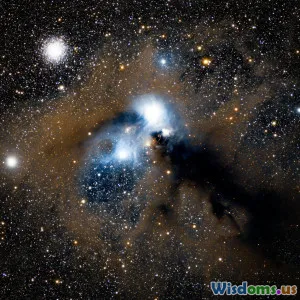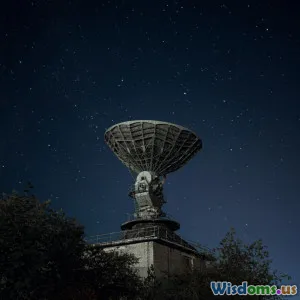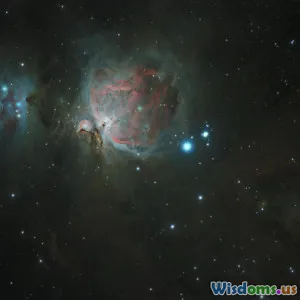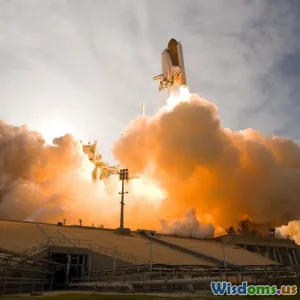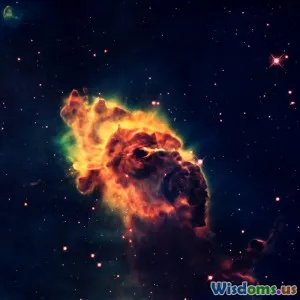
What Would Happen Without the Cosmic Microwave Background
9 min read Explore the vital role of the Cosmic Microwave Background in our universe’s evolution and what would happen without it. (0 Reviews)
What Would Happen Without the Cosmic Microwave Background?
The Cosmic Microwave Background (CMB) is often described as the faint afterglow of the Big Bang — a relic radiation that offers a snapshot of the universe just 380,000 years after its inception. But what if this pervasive cosmic whisper was never present? Imagining a universe without the CMB isn’t just a playful thought experiment; it’s an intriguing opportunity to understand the fundamental mechanisms that shaped the cosmos and, ultimately, life itself.
Introduction: The Universe’s First Light
Imagine standing on a seashore hearing the first gentle waves of a tidal surge; similarly, the CMB acts like that first ripple from the newborn universe, permeating everywhere and throughout time. Discovered accidentally by Arno Penzias and Robert Wilson in 1965, this nearly uniform microwave radiation provides critical evidence for the Big Bang theory. Without the CMB, the universe loses its oldest electromagnetic echo and a critical tool for cosmologists to read its blueprint.
But beyond its scientific utility lies its deeper significance: the CMB fingerprints the initial conditions of matter and energy, enabling the formation of stars, galaxies, planets, and life.
The Origins and Nature of the Cosmic Microwave Background
To appreciate what disappears without the CMB, we need to understand what it is.
-
Origin: Roughly 13.8 billion years ago, the universe was an intensely hot, dense plasma. As it expanded and cooled, protons and electrons combined to form neutral hydrogen during the "recombination" era, allowing photons to travel freely for the first time. Those photons have stretched into microwaves, now detectable as the CMB.
-
Characteristics: The CMB is remarkably uniform, with temperature variations of just one part in 100,000. These tiny fluctuations represent density variations that seeded galaxy formation.
Detecting and mapping these temperature shifts — most notably through missions like COBE, WMAP, and Planck — has allowed physicists to fine-tune the Universe’s composition, age, and rate of expansion.
Without the CMB: A Universe Without a Cosmic Blueprint
Without the CMB, the universe’s narrative and observed structure would be dramatically altered.
Loss of Evidence for the Big Bang
One of the strongest pillars supporting the Big Bang model is the pervasive presence of the CMB. In the absence of this radiation:
- The cosmological model would lack a crucial observable, making the Big Bang hypothesis far less certain.
- Alternative cosmologies, such as steady-state models, might dominate without decisive evidence from the CMB.
Thus, humanity’s understanding of the universe’s origins and evolution would be fundamentally obstructed.
Absence of a Cosmic Thermometer
The CMB acts like a universal thermometer, currently measuring about 2.7K (-270.45°C). It allows scientists to gauge the temperature of the universe through the epochs. Without it:
- We would struggle to reconstruct the thermal history of the universe.
- Predictions of matter formation, particle behavior, and cosmic expansion models would lack empirical grounding.
Disrupting the Formation of Cosmic Structures
Galaxies, stars, and even larger cosmic structures emerged through initial density fluctuations noticed in the CMB. These variations acted like gravitational wells, pulling matter together.
Without this “blueprint”:
- The density fluctuations that seeded galaxy and star formation might be absent or vastly different, potentially preventing large-scale structures as we know them.
- The universe might remain a more uniform, invisible gas soup, devoid of stars and planets.
Impact on Cosmic Evolution and Life
Without the formation of galaxies and stars, element synthesis through stellar nucleosynthesis—the creation of heavy elements necessary for life—would not occur.
This chain reaction would mean:
- Key elements like carbon, oxygen, iron, and calcium might not exist.
- No planets or organic chemistry framework would arise.
Simply put, the cosmic microwave background’s role indirectly enabled the conditions for life.
Theoretical Models and Simulations: How Do They Signal the CMB’s Importance?
Large-scale computational simulations like the Millennium Simulation and Illustris project model cosmic structure formation with parameters heavily relying on CMB data. Altering the presence or properties of the CMB shows:
- Galaxies lose their clumping pattern, demonstrating how seed fluctuations guide matter distribution.
- Universe's large-scale filamentary structure vanishes without correct initial conditions — something heavily informed by the CMB.
Furthermore, without CMB constraints, models predicting dark matter and dark energy fractions become more speculative and less constrained.
Experimental Insights Driven by the CMB
The CMB has not only illuminated past cosmic phases but propelled technological and methodological advances:
- Sensitive radio detectors and satellite missions purpose-built to parse faint signatures in the microwave sky.
- Adaptive filtering techniques developed from CMB data analysis influence image processing in various fields.
If the CMB were never found or was inherently absent, this cascade of scientific and technological progress might never have occurred.
Philosophical and Human Implications
Beyond the physical sciences, the CMB connects humanity to its cosmic origins. As astronomer John Mather, Nobel laureate, said,
"The discovery of the cosmic microwave background confirmed that we are part of a tangible, dynamic universe with a definable history."
Without this insight:
- Our sense of cosmic belonging and understanding of time’s origin may remain elusive.
- The narrative of existence grounded in observable science would weaken, potentially diminishing curiosity and exploration motivation.
Conclusion: The Cosmic Microwave Background as the Universe’s Primordial Echo
The cosmic microwave background is far more than just faint microwave radiation; it’s the universe’s earliest messenger, containing imprints of everything that followed. Removing it from the cosmic script would leave a universe not only scientifically inscrutable but starkly altered in structure and potential.
In sum, without the CMB:
- The Big Bang theory itself loses its cornerstone.
- The formation of stars, galaxies, and elements essential to life would be jeopardized.
- Our understanding of cosmic history, composition, and evolution would become speculative puzzles without pieces.
The CMB exemplifies how a seemingly subtle remnant of the past underpins the grand cosmic story — a testament to why uncovering and comprehending our universe’s faintest signals is vital for unlocking the mysteries of existence.
References:
- Penzias, A. A., & Wilson, R. W. (1965). A Measurement of Excess Antenna Temperature at 4080 Mc/s. Astrophysical Journal, 142, 419.
- Bennett, C. L., et al. (2013). Nine-Year Wilkinson Microwave Anisotropy Probe (WMAP) Observations: Final Maps and Results. Astrophysical Journal Supplement Series, 208(2), 20.
- Planck Collaboration (2018). Planck 2018 results. VI. Cosmological parameters. Astronomy & Astrophysics, 641, A6.
- Springel, V., et al. (2005). Simulations of the formation, evolution and clustering of galaxies and quasars. Nature, 435, 629–636.
- Mather, J. (1994). The Big Bang and the Cosmic Microwave Background Radiation. Nobel Lecture.
Rate the Post
User Reviews
Popular Posts











